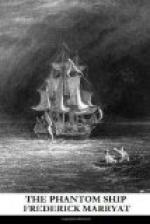“I thank you,” replied Philip; “I had, indeed, forgotten myself, and where I was: my thoughts were far away. Good-night, and many thanks.”
The Ter Schilling, like most of the vessels of that period, was very different in her build and fitting from those of the present day. She was ship-rigged, and of about four hundred tons burden. Her bottom was nearly flat, and her sides fell in (as she rose above the water), so that her upper decks were not half the width of the hold.
All the vessels employed by the Company being armed, she had her main deck clear of goods, and carried six nine-pounders on each broadside; her ports were small and oval. There was a great spring in all her decks,—that is to say, she ran with a curve forward and aft. On her forecastle another small deck ran from the knight-heads, which was called the top-gallant forecastle. Her quarter-deck was broken with a poop, which rose high out of the water. The bowsprit staved very much, and was to appearance almost as a fourth mast: the more so, as she carried a square spritsail and sprit-topsail. On her quarter-deck and poop-bulwarks were fixed in sockets implements of warfare now long in disuse, but what were then known by the names of cohorns and patteraroes; they turned round on a swivel, and were pointed by an iron handle fixed to the breech. The sail abaft the mizen-mast (corresponding to the driver or spanker of the present day) was fixed upon a lateen-yard. It is hardly necessary to add (after this description) that the dangers of a long voyage were not a little increased by the peculiar structure of the vessels, which (although with such top hamper, and so much wood above water, they could make good way before a favourable breeze) could hold no wind, and had but little chance if caught upon a lee-shore.
The crew of the Ter Schilling were composed of the captain, two mates, two pilots, and forty-five men. The supercargo had not yet come on board. The cabin (under the poop) was appropriated to the supercargo; but the main-deck cabin to the captain and mates, who composed the whole of the cabin mess.
When Philip awoke the next morning he found that the topsails were hoisted, and the anchor short-stay apeak. Some of the other vessels of the fleet were under weigh and standing out. The weather was fine and the water smooth, and the bustle and novelty of the scene were cheering to his spirits. The captain, Mynheer Kloots, was standing on the poop with a small telescope, made of pasteboard, to his eye, anxiously looking towards the town. Mynheer Kloots, as usual, had his pipe in his mouth, and the smoke which he puffed from it for a time obscured the lenses of his telescope. Philip went up the poop ladder and saluted him.




